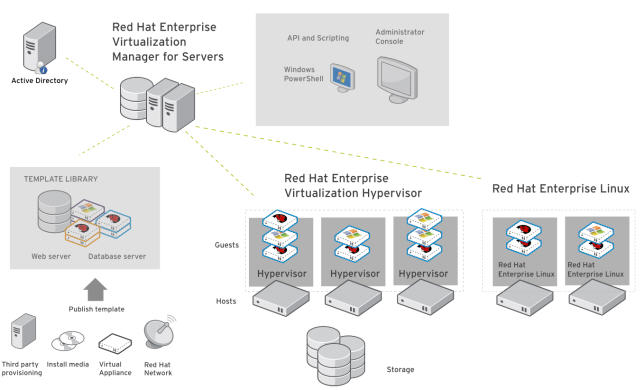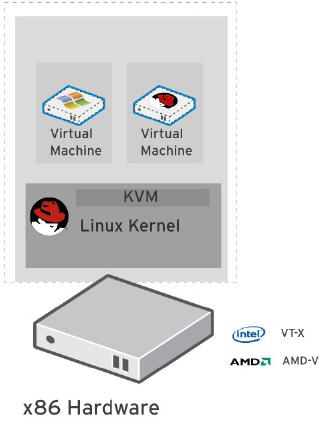Introduction
Red Hat Enterprise Virtualization is an end-to-end virtualization solution with use cases for both servers and desktops. The Red Hat Enterprise Virtualization portfolio provides IT departments with the tools to meet the challenges of managing complex environments. This state-of-the-art virtualization suite enables administrators to reduce the cost and complexity of large deployments, for example, for thousands of virtual machines.
The suite consists of the following components:
-
Red Hat Enterprise Virtualization Hypervisor, which is a thin virtualization layer deployed across the server's infrastructure.
-
Agents and tools include VDSM, which runs in the hypervisor or host. These provide local management for virtual machines, networks and storage.
-
Red Hat Enterprise Virtualization platform management infrastructure allows users to view and manage all the system components, machines and images from a single, powerful interface.

Figure 1 : The core components of the RHEV portfolio
The Red Hat Enterprise Virtualization (RHEV) Hypervisor is the core component of the RHEV suite. It is a compact, full-featured virtualization platform for quickly and easily deploying and managing virtualized guests. It is designed for integration with the Red Hat Enterprise Virtualization Manager for Servers and the Red Hat Enterprise Virtualization Manager for Desktops - this implies that you can deploy mission-critical server applications (eg., Web server, Oracle database server, etc.) or simple desktop applications (eg., Microsoft Word, Adobe Acrobat Reader/Writer, Notepad, etc.) on the VMs on the RHEV hypervisor.
This hypervisor is based on the Kernel-based Virtual Machine (KVM). KVM is an advanced and efficient virtualization hypervisor implemented as a Linux kernel module. As KVM is a kernel module, it leverages the existing Red Hat Enterprise Linux kernel and benefits from the default kernel's extensive testing, device support and flexibility.

Figure 2 : Architecture of the RHEV Hypervisor



